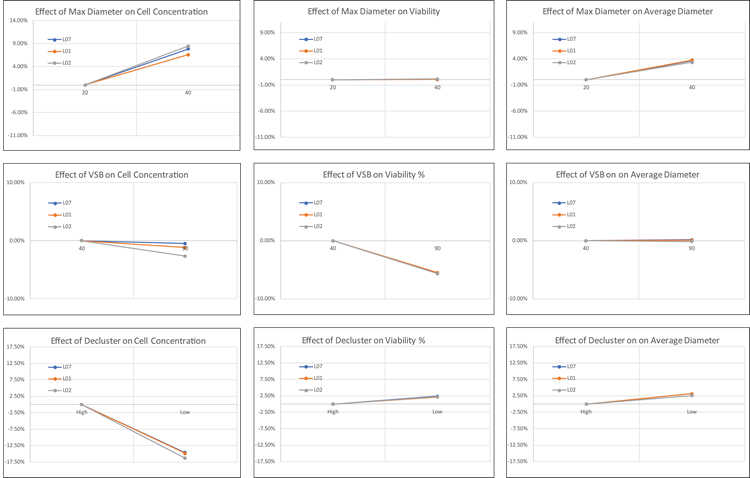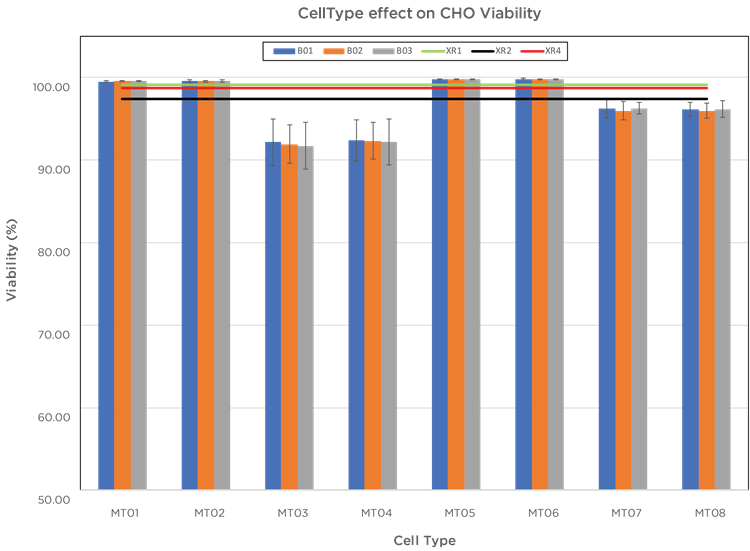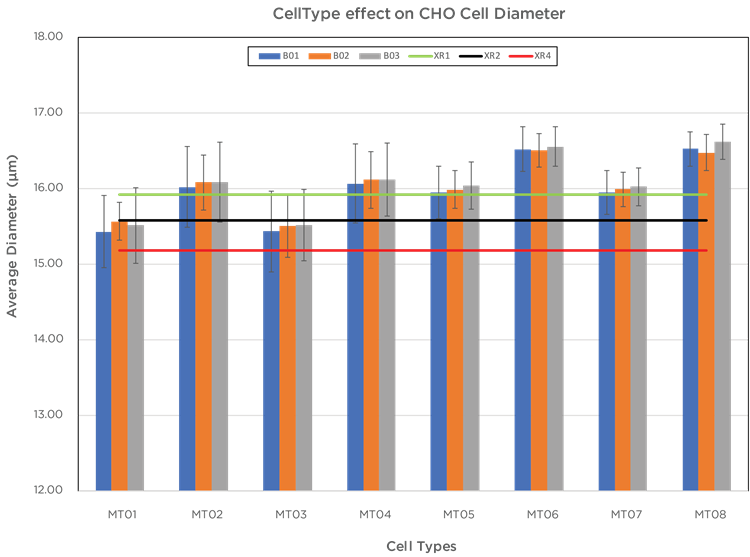Method for Determining Cell Type Parameter Adjustment to Match Legacy Vi CELL XR
With the introduction of the new Vi-CELL BLU it has now become possible to use the plate mode to perform more complex experimental designs.
One such use of this capability can be to help assist in matching Vi-CELL BLU cell types to give cell counts and viability levels equivalent to those obtained on existing Vi-CELL XR instruments.
The default cell types on Vi-CELL BLU will match relatively closely to most general cell lines but specific cell lines and more exotic cell types may require some refinement to get good agreement between the instruments.
The method outlined below leverages a straightforward factorial approach. It does not necessitate the use of extensive statistics unless desired but can quickly provide a directional indication of those
parameters have the most impact on the desired values and the direction in which to adjust them.
Experimental Design
Eight cell types were defined using the default mammalian cell type as a starting point. The values are shown in the table below.
| Cell Type | MT01 | MT02 | MT03 | MT04 | MT05 | MT06 | MT07 | MT08 |
| Minimum diameter (μm) | 6 | 6 | 6 | 6 | 6 | 6 | 6 | 6 |
| Maximum diameter (μm) | 20 | 40 | 20 | 40 | 20 | 40 | 20 | 40 |
| Images | 100 | 100 | 100 | 100 | 100 | 100 | 100 | 100 |
| Cell sharpness | 7 | 7 | 7 | 7 | 7 | 7 | 7 | 7 |
| Minimum circularity | 0.1 | 0.1 | 0.1 | 0.1 | 0.1 | 0.1 | 0.1 | 0.1 |
| Decluster degree | High | High | High | High | Low | Low | Low | Low |
| Aspiration cycles | 3 | 3 | 3 | 3 | 3 | 3 | 3 | 3 |
| Viable spot brightness (%) | 40 | 40 | 90 | 90 | 40 | 40 | 90 | 90 |
| Viable spot area (%) | 5 | 5 | 5 | 5 | 5 | 5 | 5 | 5 |
| Mixing cycles | 3 | 3 | 3 | 3 | 3 | 3 | 3 | 3 |
In this particular case we are adjusting 3 key parameters, Maximum Diameter, Viable Spot Brightness and Decluster Degree. For each parameter a high and low value are chosen to establish an extreme range for each parameter. This gives a possible 8 combinations; which is ideal for a 96 well plate layout as this will provide one row of 12 samples per Cell Type.
A 96 well plate was then loaded with CHO cells, 6 x 106 cells/ml. The plate was setup by assigning each cell type to an entire row of the plate. To offset any run time issues the plate was analyzed in Column mode so that each cell type was run one after another. This design was run in triplicate on 3 different Vi-CELL BLU instruments.

Figure 1. Plate layout for cell type analysis
Results
The results from the run were imported into MS Excel and a pivot table used to extract the data. The results were plotted as simple High:Low charts to determine the effects of the different cell type settings on the Concentration, Viability and Average Diameter values.

Figure 2. High:Low plots for adjusted cell type parameters
The results show that Maximum Diameter and Decluster degree have significant effects on Cell Concentration whereas little effect on Viability Percentage. Viable Spot Brightness has the most significant impact on Viability values as may be expected.
The above plots can help establish our expectations of what will happen when we adjust these particular parameters.
However if our goal is to match Vi-CELL XR values this approach can assist tremendously if we also run the same samples as above on the Vi-CELL XR at the same time as the above data is being collected. Then we can obtain comparison data on the same cell samples.. This was conducted for an experiment running 10 samples on 3 different Vi-CELL XRs with the default CHO cell type for the analysis.
The results below show the different cell type results from the Vi-CELL BLU machines (columns) overlaid with the average results from the Vi-CELL XR instruments (lines).



Figure 3. Comparison between Vi-CELL BLU and Vi-CELL XR using different cell type settings
The graphs above show the best matches are:
Cell Concentration the Cell Types MT02 and MT04 are the closest match with MT02 being slightly better.
Cell Viability, MT01, MT02, MT05 and MT06 match very well.
Average Diameter, all cell types except MT06 and MT08 match quite well with MT01 and MT03 spanning the Vi-CELL XR range nicely.
Based in the above settings however it would seem Cell Type MT02 gives a very acceptable match for the key parameter values. Knowing the impact of the cell type parameter adjustments from earlier it should be possible to refine the MT02 cell type even further by reducing the maximum diameter slightly to better match the Vi-CELL XR values.
Conclusions
By leveraging the plate loader on the Vi-CELL BLU it is possible to run a single experiment to very quickly obtain valuable insight into how to match Vi-CELL XR values. The plate allows for a complex experimental design and to collect sufficient sample data to have confidence in the numbers generated.

